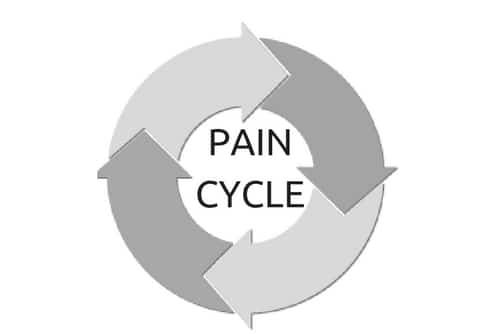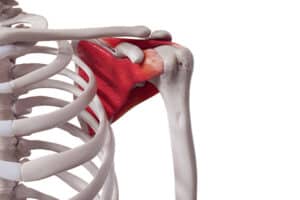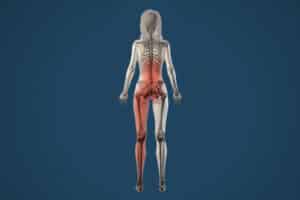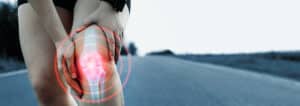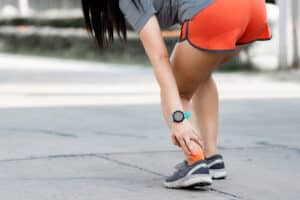The Pain Cycle – What Is It?
The pain cycle is a continuous loop of negative issues that can develop when we sustain an injury. There is a positive feedback effect that occurs throughout this loop, in the sense that increasing the amount of one factor leads to an increase in subsequent factors of the loop. The following diagram may help demonstrate the important components of the pain cycle and how the positive feedback effect works:
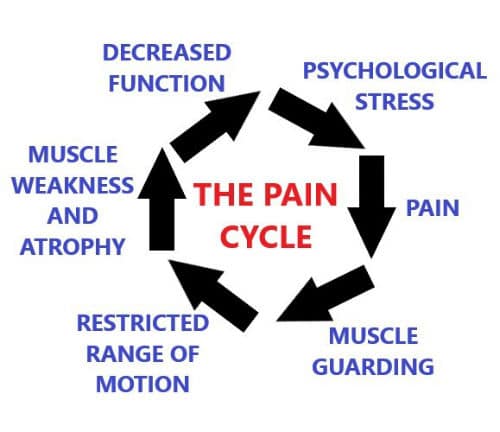
There is a lot of information packed into this diagram, but it will make more sense when each component is broken down:
- Pain: When a physical trauma occurs, such as a neck injury in a car accident, you are likely going to be confronted with pain before anything else. In this sense, you can think of pain as the catalyst in initiating the pain cycle.
- Muscle Guarding: Pain, aside from being an unpleasant sensation, acts as a signal for the body that an injury is present. Our body typically responds to this signal through the use of muscle guarding, a protective mechanism in which muscles around the site of the injury will spasm (contract involuntarily) to restrict movement. The goal of this is to prevent further injury, similar to how we might use a cast or splint in the case of a sprain or fracture.
- Restricted Range of Motion: While the purpose of muscle guarding is to minimize movement around an injured area, this can eventually become detrimental. This is because the restricted range of motion can persist after the damaged tissues have been repaired. Why this occurs is largely due to the fact that our body has already long since adapted to not using the injured area and surrounding musculature. At this point, muscle guarding is no longer serving a positive role in our body.
- For example, if your neck has been injured and has stiffened up significantly due to pain and the subsequent muscle guarding, your body will typically react to this lost range of motion by “borrowing” it from other joints in the body, also known as compensating. Instead of extending at the neck to look up, you might extend from lower in the spine. Similarly, rather than primarily rotating your neck to perform a shoulder check, you rotate more from below the neck.
- Muscle Weakness and Atrophy: Following long periods of muscle guarding and restricted movement is muscle weakness and atrophy. Our body is extremely efficient with managing its resources, and will avoid investing energy into things that are not currently serving a purpose. As such, an area that has been injured, guarded, and movement-restricted will gradually begin to weaken and suffer muscular atrophy (loss of muscle mass) over time – it simply is not being used enough to maintain a sufficient input of energy from the body.
- This is no different than why we begin to lose muscle mass if we stop working out, or why it becomes difficult to remember things if we don’t recall them for a long time. It would be wasteful for our body to continuously invest in those specific muscles or brain cell pathways if they are not something we will need in the near future.
- Decreased Function: The next stage in the pain cycle is decreased function. In reality, this has been occurring throughout the entire cycle. However, once it reaches this point, the ideal response from the body would be to start restoring function as the injured area is healed, preventing a cycle from ever being established. Of course, this is not always the case, otherwise the concept of the pain cycle would not exist.
- Psychological Stress: Various forms of psychological stress can ensue, such as: frustration, anger, depression, helplessness, and so on. Although this is not a very productive response, it is hard to blame someone for being frustrated, given the cascade of negative events that have built up to this point. Unfortunately, these various forms of stress can increase tension in our body and decrease our motivation, which eventually will lead to more pain as we continue to neglect the physical issues, such as guarding, decreased range of motion, atrophy, and loss of function.
As we can see, each component of the pain cycle feeds into the next until it meets back up with where it began, demonstrating the positive feedback effect that was mentioned earlier.
How is the Pain Cycle Broken?
In order to break the pain cycle, we need to target the factor that is fueling it the most: pain. However, there is a difference between the pain from the initial injury, and the residual pain that continues to feed into the cycle. Once the injury to the tissues (eg. contusion, fracture, sprain, strain) has healed to a functional level, the residual pain we continue to experience is actually a result of the events that took place during the dysfunctional period (refer back to the pain cycle). Thus, we should seek to rehabilitate the site as soon it is functional again.
We can employ a number of methods to deal with the residual pain. First of all are passive techniques, which can be very useful, especially in the early attempts at managing the pain cycle. The following are some examples:
- Applying heat or ice (heat is generally better for tightness/stiffness, as it promotes increased blood flow to the area, whereas ice is typically better to use on swelling/inflammation, as it will reduce the amount of blood flow to the area)
- Relaxation strategies (deep breathing, positive mental attitude, meditation, experiencing nature, and anything else that you find will help you reduce mental stress and the accompanying physical tension)
- Passive therapy (passive stretch, shockwave, massage, acupuncture, laser, percussion, and many other services that trained professionals such as physiotherapists, chiropractors, and massage therapists can provide for you)
While passive techniques can have tremendous benefits, they can also be limited in their ability to completely break the pain cycle. This is because a lot of these techniques only cause temporary relief to the problem. However, this opens the opportunity to incorporate the second major key to breaking the pain cycle: active techniques. Active techniques should be gradually incorporated once an adequate amount of function has been restored through passive rehabilitation, so the pain cycle can be broken for good.
I will define active techniques as anything in which you are physically engaging the musculature in and around the site of the injury. In other words, increasing your level of movement. This can include anything from going for a walk or run, lifting weights, performing stretches, or finding an active hobby (tennis, hiking, etc.). Kinesiologists can be very beneficial at developing a structured active rehabilitation program for you, as well as demonstrating the exercises and progressing the plan at a proper pace.
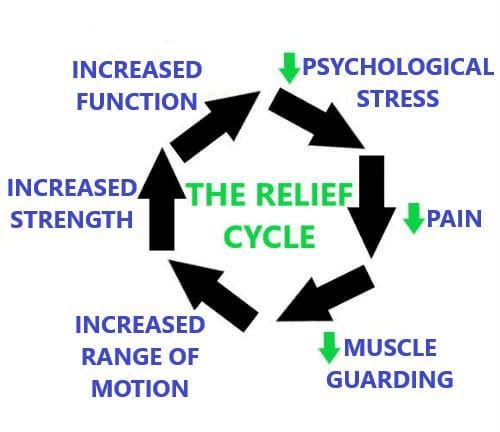
By performing both active and passive strategies at the same time, you will eventually see an opposite effect in the pain cycle – it will become more of a relief cycle. As pain is manage our muscles will guard less, which can help free up range of motion, allowing us to move more freely and build up our strength again, and so on. Eventually the passive rehabilitation will no longer be necessary, and we will instead remain active with the goal of maintaining our health, rather than rehabilitating our body. However, it takes a conscious effort from us to make these changes. The longer we sit around and hope for the best, the more we are fueling the pain cycle to make things worse.
References
Muscle Guarding – https://www.linkedin.com/pulse/what-difference-between-muscle-spasm-cramp-guarding-jane-marinelli

